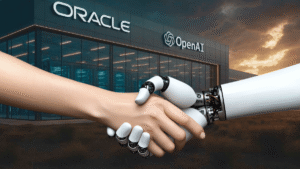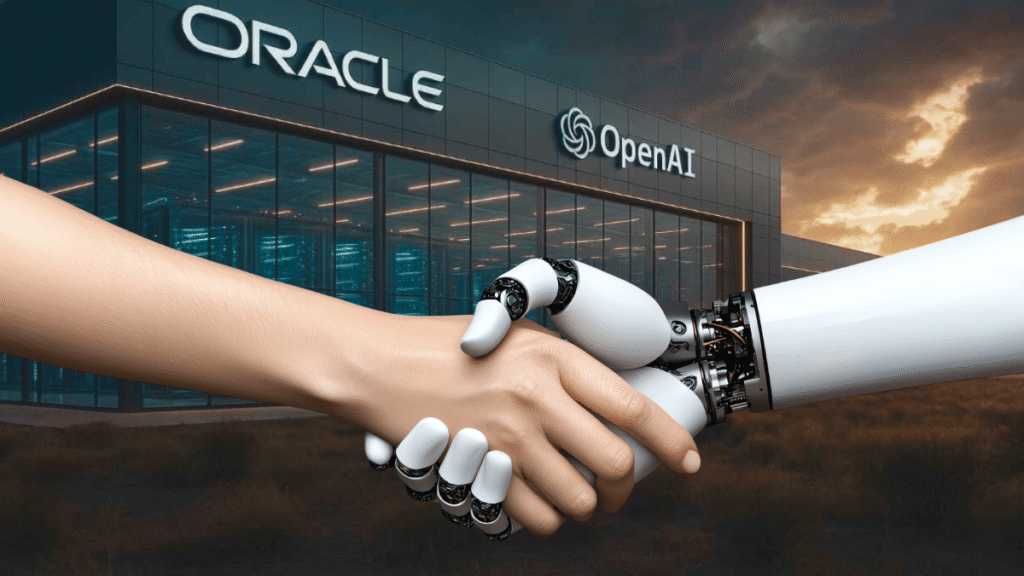OpenAI, Oracle, and SoftBank just raised the stakes in the U.S. AI arms race. Five new Stargate data centers will push their planned compute capacity to nearly 7 gigawatts — and lock in $400 billion in capital over the next three years. This accelerates their path to a 10 GW / $500 billion commitment by end of 2025. OpenAI+2Reuters+2
This matters — it reshapes where AI compute lives, who owns it, and who profits from the backbone of generative AI.
What’s happening: the facts
Stargate’s new footprint
- The five new U.S. sites, combined with the flagship Abilene, Texas facility and ongoing CoreWeave collaboration, push Stargate to ~7 GW of planned capacity. OpenAI+2Financial Times+2
- Over $400 billion is committed in the next three years toward this buildout. OpenAI+2Financial Times+2
- When fully realized, the initiative aims for 10 GW of AI compute. Reuters+2Financial Times+2
- Site locations include:
• Oracle-led: Shackelford County, Texas; Doña Ana County, New Mexico; one Midwest site (TBD) OpenAI+2WIRED+2
• SoftBank/OpenAI partnerships: Lordstown, Ohio; Milam County, Texas OpenAI+2WIRED+2 - Abilene is already operational on Oracle Cloud Infrastructure (OCI), with early training and inference workloads in motion. OpenAI
Strategic partners & bets
- Oracle is contributing heavily via its cloud infrastructure expertise and scaling of GPU racks. OpenAI+2WIRED+2
- SoftBank, via SB Energy and data-center design know-how, is enabling fast-build sites and power logistics. OpenAI+2WIRED+2
- Nvidia is reportedly investing up to $100 billion to support chip supply and infrastructure synergies. AP News+2Financial Times+2
- Over 25,000 onsite jobs are projected across the new sites, plus additional economic impact in local communities. OpenAI+2Reuters+2
Why it matters: impact across sectors
For businesses & startups
- Access to hyper-scale compute becomes more decentralized and varied. Startups may source compute not just from Big Cloud (Azure, AWS, GCP) but via Stargate-powered alternatives.
- Costs and latency may shift; colocated compute will favor proximity to new data center hubs.
- Infrastructure control translates to power in AI platform deals — especially for AI inference, fine-tuning, and model hosting.
For consumers & society
- The speed of innovation may accelerate — model training, multi-modal AI, and real-time services get fuel from denser compute.
- Environmental strain grows: power draws, water usage, and grid stress are real constraints.
For investors
- This opens new horizons: infrastructure plays (chips, power, cooling, grid services) become investable nodes in the AI stack.
- The “AI compute backbone” may emerge as a distinct asset class.
- Execution risk is high: $500B is enormous. Delays, regulatory hurdles, supply chain fragility, or energy shortages can derail ROI.
Key Takeaways
- Stargate is accelerating: five new U.S. sites bring total capacity to ~7 GW.
- Over $400 billion is committed; the full 10 GW / $500 billion plan is now expected by end 2025.
- Oracle and SoftBank divide site responsibility; Nvidia is supplying compute.
- The expansion shifts power (literally and figuratively) toward new compute hubs and alternative cloud ecosystems.
- Environmental, regulatory, and financing risks remain significant.
FAQs (Most Asked)
1. What is Stargate?
Stargate is a joint AI infrastructure venture founded by OpenAI, Oracle, SoftBank, and MGX. Its mission: build U.S. AI data center capacity at scale. WIRED+3Wikipedia+3OpenAI+3
2. How much compute capacity is Stargate targeting?
Goal: 10 GW of AI compute capacity. Current plan: ~7 GW across announced sites. Reuters+3OpenAI+3Financial Times+3
3. What is the total investment commitment?
$500 billion over the multi-year build period. Already >$400 billion is committed for the next three years. WIRED+3OpenAI+3Reuters+3
4. Where are the new data center sites?
- Oracle-led: Shackelford County TX; Doña Ana County NM; an unnamed Midwest location OpenAI+2WIRED+2
- SoftBank/OpenAI: Lordstown OH; Milam County TX OpenAI+2WIRED+2
5. How many jobs will be created?
25,000+ onsite jobs are projected for the new sites. OpenAI+2Reuters+2
6. What role does Nvidia play?
Nvidia is investing up to $100 billion to supply AI chips to these data centers. AP News+2Financial Times+2
7. How is this different from Microsoft-Azure’s AI infrastructure?
Stargate is independently controlled — compute supply, pricing, and infrastructure won’t be tied to a single cloud provider. It competes with large cloud incumbents by owning more of the stack.
8. What are the risks?
- Energy supply (electricity capacity, grid stress)
- Water usage & cooling constraints
- Permitting or local pushback
- Capital deployment and financing
- Supply chain bottlenecks for chips & power systems
9. What stage is Abilene in?
Abilene is partly operational; early compute workloads are running. Expansion is ongoing. OpenAI+2AP News+2
10. Can more U.S. sites be announced later?
Yes. The companies reviewed 300+ proposals. More locations are under evaluation. OpenAI+1
What’s next?
We’re now in a compute arms race. The winners will not just be model architects, but those who command infrastructure. Watch for:
- New site announcements (midwest, international)
- Energy & water infrastructure scaling
- Alternative compute contracts — startups may negotiate directly with Stargate for AI workloads
- Investment themes in power, cooling, grid services, and hardware
For BusinessRadarUS readers, this is your cue: map your AI roadmap to where compute is landing. Monitor CPU/GPU supply, local infrastructure, and infrastructure-as-a-service models. The future of AI depends on where the compute bricks fall.

